
小米Redmi Note 14 Pro+ 5G 评测--配备 200 万像素摄像头的中端重磅机型
新方法。
Redmi Note 14 Pro+ 5G 是小米平价中端系列中的顶级机型,配备 200 万像素高分辨率摄像头、IP 认证和明亮的 AMOLED 屏幕。我们的测试将揭晓它是否能成为内幕消息。Daniel Schmidt, 👁 Daniel Schmidt (translated by DeepL / Ninh Duy) Published 🇺🇸 🇩🇪 ...
结论:最激烈的竞争来自小米
Redmi Note 14 Pro+ 5G 与前代产品相比,几乎没有做得更好的地方--它的新 SoC 甚至略微慢了一些,但它更节能,AI 能力更强。这也是小米智能手机的新特点之一:其相当丰富的 AI 功能,这在Redmi Note 14 系列的姐妹机型中是找不到的。此外,它还支持 eSIM 卡、120 瓦快速充电和 IP68 认证。
全球机型的一个缺点是在电池和缺乏光学变焦方面节省了技术成本。后者尤其令人遗憾,因为附加镜头并不是最好的。此外,这款智能手机的发布版本是Android 14,这意味着承诺的三个版本升级没有最初看起来那么慷慨。另外,小米在自己的队伍中还有一个强劲的竞争对手,即 Poco X7 Pro,它提供的人工智能更少,但速度更快。
Pros
Cons
价格和供应情况
您可以在亚马逊等主要在线零售商处订购小米Redmi Note 14 Pro+ 5G,目前售价为 429.50 美元。
可能的替代品比较
Image | Model / Review | Price | Weight | Drive | Display |
|---|---|---|---|---|---|
| Xiaomi Redmi Note 14 Pro+ 5G Qualcomm Snapdragon 7s Gen 3 ⎘ Qualcomm Adreno 810 ⎘ 12 GB Memory, 512 GB UFS 2.1 | Amazon: 1. $349.50 Xiaomi Redmi Note 13 Pro 5G ... 2. $314.99 Xiaomi Redmi Note 13 Pro 5G ... 3. $6.99 Suttkue for Xiaomi Redmi Not... List Price: 530€ | 205 g | 512 GB UFS 2.2 Flash | 6.67" 2712x1220 446 PPI AMOLED | |
| Google Pixel 8a Google Tensor G3 ⎘ ARM Mali-G715 MP7 ⎘ 8 GB Memory, 128 GB | Amazon: $487.00 List Price: 549€ | 188 g | 128 GB UFS 3.1 Flash | 6.10" 2400x1080 431 PPI AMOLED | |
| Samsung Galaxy A55 5G Samsung Exynos 1480 ⎘ Samsung Xclipse 530 ⎘ 8 GB Memory, 256 GB | Amazon: 1. $6.89 NEW'C 3 Pack Designed for Sa... 2. $5.99 Supershieldz (2 Pack) Design... 3. $9.99 Samsung Galaxy A55/A35 5G Sc... List Price: 529€ | 213 g | 256 GB UFS 3.1 Flash | 6.60" 2340x1080 390 PPI Super AMOLED | |
| Xiaomi Poco X7 Pro MediaTek Dimensity 8400 ⎘ ARM Immortalis-G720 MP7 ⎘ 12 GB Memory, 512 GB | Amazon: 1. $7.99 Suttkue for Xiaomi Poco X7 P... 2. $249.99 Xiaomi Poco M6 Pro 4G Lte Gs... 3. $11.99 Ibywind Screen Protector For... List Price: 430€ | 198 g | 512 GB UFS 4.0 Flash | 6.67" 2712x1220 446 PPI AMOLED | |
| Motorola Edge 50 Neo MediaTek Dimensity 7300 ⎘ ARM Mali-G615 MP2 ⎘ 12 GB Memory, 512 GB | Amazon: 1. $6.95 Mr.Shield Screen Protector c... 2. $8.99 Iiseon High Sensitivity Hydr... 3. $8.99 NECARSIN 3 Pack for Motorola... List Price: 499€ | 171 g | 512 GB UFS 3.1 Flash | 6.40" 2670x1220 459 PPI P-OLED |
Table of Contents
- 结论:最激烈的竞争来自小米
- 规格 Redmi Note 14 Pro+ 5G
- 保护壳 - 用于Redmi Note 14 Pro+ 5G 的大猩猩玻璃 Victus 2
- 连通性 - 附加费和倒退
- 软件 -Redmi Note 14 Pro+ 5G 四年更新一次
- 通信和全球导航卫星系统 - 配备三频无线局域网的小米手机
- 电话功能和通话质量 - 支持 eSIM 的Redmi Note 14 Pro+ 5G
- 相机 - 不带光学变焦的全球版本
- 附件和保修 -Redmi Note 14 Pro+ 5G 不带电源
- 输入设备和操作 - 480 赫兹的小米智能手机
- 显示屏 -Redmi Note 14 Pro+ 5G 上的超亮 120 Hz OLED 显示屏
- 性能 - 搭载骁龙 7s 第三代处理器的红米智能手机
- 游戏 - 大部分游戏可达到 60fps
- 排放 -Redmi Note 14 Pro+ 5G 上的双扬声器
- 电池寿命 - 5,110 毫安时的长续航时间
- Notebookcheck 总评分
Pro Plus 5G 是小米Redmi Note 14 系列中的顶级机型,是 13 Pro+ 5G 的直接继承者。 Redmi Note 13 Pro+ 5G.查看其数据表可以发现,小米不仅更换了 SoC,还更换了存储空间。不幸的是,这被证明是一次降级,配备 LPDDR5 和 UFS 3.1 的机型被保留给了中国市场。
总的来说,小米似乎对这款面向国内市场的机型采取了一些不同的做法:它的摄像头设置由两个 5000 万像素的传感器组成,其中第二个是光学变焦,只有超广角与我们的测试机型相同。它的 6200 毫安时电池也更加强劲。另一方面,快速充电速度较慢,而且中国机型不支持 eSIM 卡。
如果不是这两款智能手机外观相同,你可能会认为它们是不同的机型。此外,Redmi Note 14 系列在中国要便宜得多,即使已经考虑了通常的进口税和附加税。
规格 Redmi Note 14 Pro+ 5G
» Notebookcheck多媒体笔记本电脑Top 10排名
» Notebookcheck游戏笔记本电脑Top 10排名
» Notebookcheck低价办公/商务笔记本电脑Top 10排名
» Notebookcheck高端办公/商务笔记本电脑Top 10排名
» Notebookcheck工作站笔记本电脑Top 10排名
» Notebookcheck亚笔记本电脑Top 10排名
» Notebookcheck超级本产品Top 10排名
» Notebookcheck变形本产品Top 10排名
» Notebookcheck平板电脑Top 10排名
» Notebookcheck智能手机Top 10排名
» Notebookcheck评测过最出色的笔记本电脑屏幕
» Notebookcheck售价500欧元以下笔记本电脑Top 10排名
» Notebookcheck售价300欧元以下笔记本电脑Top 10排名
保护壳 - 用于Redmi Note 14 Pro+ 5G 的大猩猩玻璃 Victus 2
小米Redmi Note 14 Pro+ 5G 有冰霜蓝、午夜黑和薰衣草紫三种颜色。后者也是我们的测试机,采用了仿皮背壳。它的屏占比高达 88%,非常出色。圆润的显示屏边缘让人感觉非常纤薄,尽管重达 201 克,但拿在手上却非常舒适。
我们非常喜欢这款手机的制造质量。所有缝隙都紧密均匀,当我们试图扭动红米智能手机时,它也不会发出任何嘎吱声。它通过了 IP68 认证,这意味着它既防尘又防水。
背面的摄像头模块看起来很强大,但不会让人感觉头重脚轻。它现在采用了铝制边框,有些地方还经过了磨砂处理。该设备的显示屏再次受到康宁大猩猩玻璃 Victus 2 的保护。
连通性 - 附加费和倒退
Redmi Note 14 Pro+ 5G 的全球版本再次提供两种存储容量:8/256 GB 和 12/512 GB,但现在这两种机型的价格会稍高一些。较小的型号价格约为 520 美元,较大的型号价格约为 550 美元。此外,这两个版本现在都只使用 LPDDR4x 和 UFS 2.2。
除此之外,这款小米智能手机的配置也不错,除了蓝牙 5.4 和 NFC 外,还配备了红外爆破器和 eSIM 支持。不出所料,它的 USB 2.0 端口在拷贝测试中没有达到最佳数值,仅为 29.43 MB/s。不过,让我们感到有些意外的是,这款顶级产品的输出电压有所降低,这就是为什么我们在华硕 ROG Strix Arion 机箱中使用的三星 980 Pro 在连接到它时无法运行,而我们不得不使用更省钱的 三星 PSSD T7.
我们在测试中还注意到,当我们将智能手机连接到电脑时,它的存储访问速度非常慢。
软件 -Redmi Note 14 Pro+ 5G 四年更新一次
小米手机的操作系统是Android 14 和 HyperOS 1.0,遗憾的是还没有更新的Android 15。这意味着所承诺的三次主要更新将在Android 17 时结束。安全补丁的有效期为四年。目前尚不清楚安全补丁的推出时间间隔。在测试时,安全补丁的日期是 2024 年 12 月 1 日,而 Play 系统更新的日期仍然是 2024 年 7 月 1 日。虽然它是该系列中最昂贵的智能手机,但令人惊讶的是,它并没有获得最长时间的更新--这些更新是留给 Redmi Note 14 LTE的更新时间为 4 + 6 年。
尽管如此,Redmi Note 14 Pro+ 5G 还支持小米的互联功能,允许连接到同一小米账户的设备无缝协同工作。此外,还搭载了一些 AI 功能,如 Note 应用中的校对或翻译、图像增强、图像橡皮擦、实时翻译和 Circle to Search。
可持续性
小米Redmi Note 14 Pro+ 5G 包装在一个完全由硬纸板制成的纸盒中,但不幸的是,它被塑料薄膜包裹着。此外,包装盒内还使用了两层薄膜来包裹手机壳和智能手机,这两层薄膜似乎是由可堆肥的生物塑料制成的。
这款智能手机不能由用户自行维修,因此小米公司没有提供任何维修说明。制造商也没有提供任何有关其二氧化碳排放量的信息或可持续发展报告。
通信和全球导航卫星系统 - 配备三频无线局域网的小米手机
小米Redmi Note 14 Pro+ 5G 支持所有移动通信标准的各种频率,包括 5G Sub6。在我们的测试中,它在大都市环境中的接收效果良好,无可挑剔。
红米智能手机的 Wi-Fi 6E 支持所有三个 Wi-Fi 频段,与华硕 ROG Rapture GT-AXE11000 参考路由器配合使用时,传输速率基本稳定。
| Networking | |
| Xiaomi Redmi Note 14 Pro+ 5G | |
| iperf3 transmit AXE11000 | |
| iperf3 receive AXE11000 | |
| iperf3 transmit AXE11000 6GHz | |
| iperf3 receive AXE11000 6GHz | |
| Google Pixel 8a | |
| iperf3 transmit AXE11000 | |
| iperf3 receive AXE11000 | |
| iperf3 transmit AXE11000 6GHz | |
| iperf3 receive AXE11000 6GHz | |
| Samsung Galaxy A55 5G | |
| iperf3 transmit AXE11000 | |
| iperf3 receive AXE11000 | |
| Xiaomi Poco X7 Pro | |
| iperf3 transmit AXE11000 | |
| iperf3 receive AXE11000 | |
| Motorola Edge 50 Neo | |
| iperf3 transmit AXE11000 | |
| iperf3 receive AXE11000 | |
| Average Wi-Fi 6E | |
| iperf3 transmit AXE11000 | |
| iperf3 receive AXE11000 | |
| iperf3 transmit AXE11000 6GHz | |
| iperf3 receive AXE11000 6GHz | |
| Average of class Smartphone | |
| iperf3 transmit AXE11000 | |
| iperf3 receive AXE11000 | |
| iperf3 transmit AXE11000 6GHz | |
| iperf3 receive AXE11000 6GHz | |
Redmi Note 14 Pro+ 5G 支持连接卫星网络的所有全球网络,但只能使用单频连接。不过,它的卫星定位能力在户外非常快速准确。
在一次短途步行中,我们将智能手机的定位精度与 Garmin Venu 2.Redmi Note 14 Pro+ 被证明更加准确,尤其是在比较困难的情况下,在日常生活中应始终可靠地引导用户到达目的地。
电话功能和通话质量 - 支持 eSIM 的Redmi Note 14 Pro+ 5G
小米Redmi Note 14 Pro+ 5G 的通话质量在贴近耳朵时不错,在安静的环境中也能自然还原声音。不过,它的背景噪声抑制效果并不好。支持 VoLTE 和 Wi-Fi 通话。
这款智能手机可容纳两张 nano SIM 卡。如果没有第二个插槽,也可以激活 eSIM 卡。
相机 - 不带光学变焦的全球版本
手机正面的 2000 万像素镜头具有固定焦距、集成提词器功能,并能以高达 60fps 的速度录制全高清视频。
背面三摄像头的核心是一个 200 万像素的传感器,采用光学防抖技术。在日光下,它能拍摄出不错的照片,尽管在细节和动态方面略有欠缺。在弱光环境下也是如此,但我们喜欢它的光线构成,尽管照片噪点较多,缺乏细节。
附加的超广角镜头只有 800 万像素的分辨率,拍摄效果的细节也相应较差。用它拍摄的照片在色调上也显得非常冷淡。使用 200 万像素微距镜头拍摄的照片噪点较多,即使在光线条件良好的情况下也几乎无法使用。
主传感器采用的完全是数字变焦,因为与中国市场的版本不同,世界其他地区无法使用光学变焦。虽然 2 倍的放大率仍能带来不错的效果,但 4 倍变焦时细节已经变得平淡无奇,超过 4 倍变焦后也不会有更好的效果。最大可实现 30 倍数码变焦,但图像稳定功能显然难以满足要求,而且与更昂贵的机型不同,该应用中没有集成额外的电子取景器。
最多只能以 24 或 30fps 的超高清速度录制视频,而对于喜欢全高清的用户,最高可达到 60fps。它的图像防抖效果不错,但偶尔会导致图像有点滞后。声音效果不错,但能听到一些明显的噪音。
Image Comparison
Choose a scene and navigate within the first image. One click changes the position on touchscreens. One click on the zoomed-in image opens the original in a new window. The first image shows the scaled photograph of the test device.
Main cameraMain cameraUltra-wide angle5x zoomLow-light
在受控照明条件下,Redmi Note 14 Pro+ 5G 在色彩再现方面没有出现任何重大异常。ColorChecker 图像中偏差最大的是青色,DeltaE 约为 10.2。
我们的测试图使用 200-MPix 模式拍摄,细节表现良好,但在彩色区域往往会忽略一些细节。


附件和保修 -Redmi Note 14 Pro+ 5G 不带电源
Redmi Note 14 Pro+ 5G 随附一条 USB 数据线、一个黑色硅胶保护套和一个 SIM 卡工具。不过,欧盟和英国的机型没有电源适配器,考虑到其 120 瓦的快速充电选项,这一点尤其令人失望。小米公司提供的合适充电器价格约为 60 美元。
小米只为其智能手机提供 12 个月的保修服务。您可以选择购买小米关怀保险套餐,该套餐可为两年内的意外损坏或盗窃提供保障。
输入设备和操作 - 480 赫兹的小米智能手机
显示屏 -Redmi Note 14 Pro+ 5G 上的超亮 120 Hz OLED 显示屏
手机的 6.7 英寸 AMOLED 显示屏分辨率为 2,712 x 1,220 像素,像素密度很高。它的刷新率高达 120 Hz,可在 60、90 或 120 Hz 下动态工作。您也可以手动设置为 60 或 120 Hz。Redmi Note 14 Pro+ 5G 支持所有常见的 HDR 标准。
在显示全白屏幕时,其亮度可达 1,210 cd/m²--这是一个不错的值,但当屏幕面积缩小时,亮度几乎不会变亮(APL18:1,280 cd/m²)。只有在显示 HDR 内容时,它才能达到 3,081 cd/m² 的峰值亮度。
与所有 OLED 屏幕一样,这块屏幕也会闪烁。除了 120 Hz 的低频基频外,我们还测量到 1923 Hz 的高频 PWM 调光(在最低显示亮度下)。因此,该面板相对来说比较养眼,但我们也不能完全排除特别敏感用户的抱怨。
| |||||||||||||||||||||||||
Brightness Distribution: 92 %
Center on Battery: 1210 cd/m²
Contrast: ∞:1 (Black: 0 cd/m²)
ΔE Color 1 | 0.5-29.43 Ø4.87
ΔE Greyscale 1.5 | 0.5-98 Ø5.1
99.1% sRGB (Calman 2D)
Gamma: 2.25
| Xiaomi Redmi Note 14 Pro+ 5G AMOLED, 2712x1220, 6.7" | Google Pixel 8a AMOLED, 2400x1080, 6.1" | Samsung Galaxy A55 5G Super AMOLED, 2340x1080, 6.6" | Xiaomi Poco X7 Pro AMOLED, 2712x1220, 6.7" | Motorola Edge 50 Neo P-OLED, 2670x1220, 6.4" | Xiaomi Redmi Note 13 Pro+ 5G AMOLED, 2712x1220, 6.7" | |
|---|---|---|---|---|---|---|
| Screen | -6% | -15% | 0% | -27% | 4% | |
| Brightness middle | 1210 | 1518 25% | 962 -20% | 1034 -15% | 1246 3% | 1240 2% |
| Brightness | 1222 | 1466 20% | 967 -21% | 1041 -15% | 1235 1% | 1233 1% |
| Brightness Distribution | 92 | 88 -4% | 99 8% | 97 5% | 98 7% | 98 7% |
| Black Level * | ||||||
| Colorchecker dE 2000 * | 1 | 1.2 -20% | 1.6 -60% | 1 -0% | 1.8 -80% | 1.1 -10% |
| Colorchecker dE 2000 max. * | 2.7 | 3.3 -22% | 2.6 4% | 2.2 19% | 3.81 -41% | 2.2 19% |
| Greyscale dE 2000 * | 1.5 | 2 -33% | 1.5 -0% | 1.4 7% | 2.3 -53% | 1.4 7% |
| Gamma | 2.25 98% | 2.2 100% | 2.13 103% | 2.22 99% | 2.191 100% | 2.21 100% |
| CCT | 6509 100% | 6786 96% | 6382 102% | 6553 99% | 6488 100% | 6669 97% |
* ... smaller is better
| Display / HDR Peak Brightness | |
| Xiaomi Redmi Note 14 Pro+ 5G | |
| Xiaomi Poco X7 Pro | |
| Google Pixel 8a | |
| Samsung Galaxy A55 5G | |
| Display / APL18 Peak Brightness | |
| Google Pixel 8a | |
| Samsung Galaxy A55 5G | |
| Xiaomi Poco X7 Pro | |
| Xiaomi Redmi Note 14 Pro+ 5G | |
Screen Flickering / PWM (Pulse-Width Modulation)
| Screen flickering / PWM detected | 120 Hz Amplitude: 15.71 % Secondary Frequency: 1923 Hz | ||
The display backlight flickers at 120 Hz (worst case, e.g., utilizing PWM) . The frequency of 120 Hz is very low, so the flickering may cause eyestrain and headaches after extended use. In comparison: 53 % of all tested devices do not use PWM to dim the display. If PWM was detected, an average of 8516 (minimum: 5 - maximum: 343500) Hz was measured. | |||
固定缩放级别和不同亮度设置下的测量系列(最低亮度下的振幅曲线看起来很平,但这是缩放造成的。信息框显示的是最小亮度下的振幅放大图)。
在显示设置中选择Original Color PRO色彩方案和暖色调色温,就能获得最自然的屏幕效果。Redmi Note 14 Pro+ 5G 在色彩表现方面没有出现任何失误,也没有过度使用饱和度。预设的鲜艳 模式明显偏冷,使用的色彩饱和度更高。
Display Response Times
| ↔ Response Time Black to White | ||
|---|---|---|
| 1.41 ms ... rise ↗ and fall ↘ combined | ↗ 0.752 ms rise | |
| ↘ 0.6575 ms fall | ||
| The screen shows very fast response rates in our tests and should be very well suited for fast-paced gaming. In comparison, all tested devices range from 0.1 (minimum) to 240 (maximum) ms. » 6 % of all devices are better. This means that the measured response time is better than the average of all tested devices (20.8 ms). | ||
| ↔ Response Time 50% Grey to 80% Grey | ||
| 1.79 ms ... rise ↗ and fall ↘ combined | ↗ 0.925 ms rise | |
| ↘ 0.86 ms fall | ||
| The screen shows very fast response rates in our tests and should be very well suited for fast-paced gaming. In comparison, all tested devices range from 0.165 (minimum) to 636 (maximum) ms. » 6 % of all devices are better. This means that the measured response time is better than the average of all tested devices (32.5 ms). | ||
性能 - 搭载骁龙 7s 第三代处理器的红米智能手机
小米智能手机采用 骁龙 7s 第 3 代,可使用 8 或 12 GB LPDDR4x 内存。从技术上讲,考虑到Redmi Note 14 Pro+ 5G 的价格区间,也可以使用更快的 LPDDR5 内存,而且可能更合适。
在纯 CPU 性能方面,4 纳米 SoC 表现出色,但被 Exynos 1480在 Geekbench 多核测试中不敌 Exynos 1480。在 像素 8a(张力 G3)和 Poco X7 Pro(Dimensity 8400)在这种情况下都处于不同的水平。系统和人工智能基准测试的情况也差不多。
在日常使用中,系统大部分时间都能流畅运行,但在较长时间的休息后,主屏幕加载可能需要两秒左右的时间。
| UL Procyon AI Inference for Android - Overall Score NNAPI | |
| Xiaomi Poco X7 Pro | |
| Google Pixel 8a | |
| Xiaomi Redmi Note 13 Pro+ 5G | |
| Average of class Smartphone (1267 - 81594, n=153, last 2 years) | |
| Average Qualcomm Snapdragon 7s Gen 3 (8460 - 8652, n=3) | |
| Xiaomi Redmi Note 14 Pro+ 5G | |
| Samsung Galaxy A55 5G | |
| Geekbench AI | |
| Single Precision TensorFlow NNAPI 1.1 | |
| Average of class Smartphone (122 - 4619, n=45, last 2 years) | |
| Motorola Edge 50 Neo | |
| Xiaomi Redmi Note 14 Pro+ 5G | |
| Average Qualcomm Snapdragon 7s Gen 3 (n=1) | |
| Samsung Galaxy A55 5G | |
| Half Precision TensorFlow NNAPI 1.1 | |
| Average of class Smartphone (122 - 32432, n=45, last 2 years) | |
| Motorola Edge 50 Neo | |
| Xiaomi Redmi Note 14 Pro+ 5G | |
| Average Qualcomm Snapdragon 7s Gen 3 (n=1) | |
| Samsung Galaxy A55 5G | |
| Quantized TensorFlow NNAPI 1.1 | |
| Average of class Smartphone (118 - 44657, n=45, last 2 years) | |
| Motorola Edge 50 Neo | |
| Xiaomi Redmi Note 14 Pro+ 5G | |
| Average Qualcomm Snapdragon 7s Gen 3 (n=1) | |
| Samsung Galaxy A55 5G | |
集成的 Adreno 810负责图形计算,其速度之慢令人惊讶,计算能力甚至低于 ARM Mali-G610 MP4的 前代机型.
GFXBench (DX / GLBenchmark) 2.7: T-Rex Onscreen | 1920x1080 T-Rex Offscreen
GFXBench 3.0: on screen Manhattan Onscreen OGL | 1920x1080 1080p Manhattan Offscreen
GFXBench 3.1: on screen Manhattan ES 3.1 Onscreen | 1920x1080 Manhattan ES 3.1 Offscreen
GFXBench: on screen Car Chase Onscreen | 1920x1080 Car Chase Offscreen | on screen Aztec Ruins High Tier Onscreen | 2560x1440 Aztec Ruins High Tier Offscreen | on screen Aztec Ruins Normal Tier Onscreen | 1920x1080 Aztec Ruins Normal Tier Offscreen | 3840x2160 4K Aztec Ruins High Tier Offscreen
| 3DMark / Wild Life Extreme Unlimited | |
| Xiaomi Poco X7 Pro | |
| Google Pixel 8a | |
| Xiaomi Redmi Note 13 Pro+ 5G | |
| Xiaomi Redmi Note 14 Pro+ 5G | |
| Samsung Galaxy A55 5G | |
| Motorola Edge 50 Neo | |
| 3DMark / Wild Life Extreme | |
| Xiaomi Poco X7 Pro | |
| Google Pixel 8a | |
| Xiaomi Redmi Note 13 Pro+ 5G | |
| Xiaomi Redmi Note 14 Pro+ 5G | |
| Samsung Galaxy A55 5G | |
| Motorola Edge 50 Neo | |
| 3DMark / Wild Life Unlimited Score | |
| Xiaomi Poco X7 Pro | |
| Google Pixel 8a | |
| Xiaomi Redmi Note 13 Pro+ 5G | |
| Xiaomi Redmi Note 14 Pro+ 5G | |
| Samsung Galaxy A55 5G | |
| Motorola Edge 50 Neo | |
| 3DMark / Wild Life Score | |
| Google Pixel 8a | |
| Xiaomi Redmi Note 13 Pro+ 5G | |
| Xiaomi Redmi Note 14 Pro+ 5G | |
| Samsung Galaxy A55 5G | |
| Motorola Edge 50 Neo | |
| Xiaomi Poco X7 Pro | |
| 3DMark / Steel Nomad Light Unlimited Score | |
| Xiaomi Poco X7 Pro | |
| Google Pixel 8a | |
| Xiaomi Redmi Note 14 Pro+ 5G | |
| Motorola Edge 50 Neo | |
| 3DMark / Steel Nomad Light Score | |
| Xiaomi Poco X7 Pro | |
| Google Pixel 8a | |
| Xiaomi Redmi Note 14 Pro+ 5G | |
| Motorola Edge 50 Neo | |
| GFXBench (DX / GLBenchmark) 2.7 / T-Rex Onscreen | |
| Xiaomi Poco X7 Pro | |
| Google Pixel 8a | |
| Xiaomi Redmi Note 13 Pro+ 5G | |
| Samsung Galaxy A55 5G | |
| Xiaomi Redmi Note 14 Pro+ 5G | |
| GFXBench (DX / GLBenchmark) 2.7 / T-Rex Offscreen | |
| Xiaomi Poco X7 Pro | |
| Google Pixel 8a | |
| Xiaomi Redmi Note 13 Pro+ 5G | |
| Samsung Galaxy A55 5G | |
| Xiaomi Redmi Note 14 Pro+ 5G | |
| GFXBench 3.0 / Manhattan Onscreen OGL | |
| Xiaomi Poco X7 Pro | |
| Google Pixel 8a | |
| Xiaomi Redmi Note 13 Pro+ 5G | |
| Samsung Galaxy A55 5G | |
| Xiaomi Redmi Note 14 Pro+ 5G | |
| GFXBench 3.0 / 1080p Manhattan Offscreen | |
| Xiaomi Poco X7 Pro | |
| Google Pixel 8a | |
| Xiaomi Redmi Note 13 Pro+ 5G | |
| Samsung Galaxy A55 5G | |
| Xiaomi Redmi Note 14 Pro+ 5G | |
| GFXBench 3.1 / Manhattan ES 3.1 Onscreen | |
| Xiaomi Poco X7 Pro | |
| Google Pixel 8a | |
| Samsung Galaxy A55 5G | |
| Xiaomi Redmi Note 13 Pro+ 5G | |
| Xiaomi Redmi Note 14 Pro+ 5G | |
| GFXBench 3.1 / Manhattan ES 3.1 Offscreen | |
| Xiaomi Poco X7 Pro | |
| Google Pixel 8a | |
| Xiaomi Redmi Note 13 Pro+ 5G | |
| Samsung Galaxy A55 5G | |
| Xiaomi Redmi Note 14 Pro+ 5G | |
| GFXBench / Car Chase Onscreen | |
| Xiaomi Poco X7 Pro | |
| Google Pixel 8a | |
| Samsung Galaxy A55 5G | |
| Xiaomi Redmi Note 13 Pro+ 5G | |
| Xiaomi Redmi Note 14 Pro+ 5G | |
| GFXBench / Car Chase Offscreen | |
| Xiaomi Poco X7 Pro | |
| Google Pixel 8a | |
| Xiaomi Redmi Note 13 Pro+ 5G | |
| Samsung Galaxy A55 5G | |
| Xiaomi Redmi Note 14 Pro+ 5G | |
| GFXBench / Aztec Ruins High Tier Onscreen | |
| Xiaomi Poco X7 Pro | |
| Google Pixel 8a | |
| Samsung Galaxy A55 5G | |
| Xiaomi Redmi Note 13 Pro+ 5G | |
| Xiaomi Redmi Note 14 Pro+ 5G | |
| Motorola Edge 50 Neo | |
| GFXBench / Aztec Ruins High Tier Offscreen | |
| Xiaomi Poco X7 Pro | |
| Google Pixel 8a | |
| Xiaomi Redmi Note 13 Pro+ 5G | |
| Xiaomi Redmi Note 14 Pro+ 5G | |
| Samsung Galaxy A55 5G | |
| Motorola Edge 50 Neo | |
| GFXBench / Aztec Ruins Normal Tier Onscreen | |
| Xiaomi Poco X7 Pro | |
| Google Pixel 8a | |
| Samsung Galaxy A55 5G | |
| Xiaomi Redmi Note 13 Pro+ 5G | |
| Xiaomi Redmi Note 14 Pro+ 5G | |
| Motorola Edge 50 Neo | |
| GFXBench / Aztec Ruins Normal Tier Offscreen | |
| Xiaomi Poco X7 Pro | |
| Google Pixel 8a | |
| Xiaomi Redmi Note 13 Pro+ 5G | |
| Xiaomi Redmi Note 14 Pro+ 5G | |
| Samsung Galaxy A55 5G | |
| Motorola Edge 50 Neo | |
| GFXBench / 4K Aztec Ruins High Tier Offscreen | |
| Xiaomi Poco X7 Pro | |
| Google Pixel 8a | |
| Xiaomi Redmi Note 13 Pro+ 5G | |
| Xiaomi Redmi Note 14 Pro+ 5G | |
| Samsung Galaxy A55 5G | |
| Motorola Edge 50 Neo | |
在浏览器基准测试中,Redmi Note 14 Pro+ 5G 浏览器排名居中。对这款手机来说,日常网页浏览不成问题,但包含 Java 元素的网站加载时间稍长。
| Jetstream 2 - 2.0 Total Score | |
| Xiaomi Poco X7 Pro (Chrome 132.0.6834.163) | |
| Average Qualcomm Snapdragon 7s Gen 3 (118 - 161.6, n=3) | |
| Average of class Smartphone (13.8 - 387, n=171, last 2 years) | |
| Samsung Galaxy A55 5G (Chrome 123) | |
| Xiaomi Redmi Note 14 Pro+ 5G (Chrome 132) | |
| Google Pixel 8a (Chrome 126) | |
| Xiaomi Redmi Note 13 Pro+ 5G (Chrome 122.0.6261.90) | |
| Speedometer 2.0 - Result | |
| Xiaomi Poco X7 Pro (Chrome 132.0.6834.163) | |
| Average Qualcomm Snapdragon 7s Gen 3 (144 - 176, n=3) | |
| Google Pixel 8a (Chrome 126) | |
| Average of class Smartphone (15.2 - 569, n=151, last 2 years) | |
| Xiaomi Redmi Note 14 Pro+ 5G (Chrome 132) | |
| Samsung Galaxy A55 5G (Chrome 123) | |
| Xiaomi Redmi Note 13 Pro+ 5G (Chrome 122.0.6261.90) | |
| Speedometer 3.0 - Score | |
| Average of class Smartphone (1.03 - 34, n=90, last 2 years) | |
| Xiaomi Poco X7 Pro (Chrome 132.0.6834.163) | |
| Google Pixel 8a (Chrome 126) | |
| Average Qualcomm Snapdragon 7s Gen 3 (8.58 - 11.2, n=3) | |
| Xiaomi Redmi Note 14 Pro+ 5G (Chrome 132) | |
| Samsung Galaxy A55 5G (Chrome 123) | |
| Xiaomi Redmi Note 13 Pro+ 5G (Chrome 122.0.6261.90) | |
| WebXPRT 4 - Overall | |
| Xiaomi Poco X7 Pro (Chrome 132.0.6834.163) | |
| Average Qualcomm Snapdragon 7s Gen 3 (110 - 149, n=3) | |
| Samsung Galaxy A55 5G (Chrome 123) | |
| Average of class Smartphone (22 - 271, n=162, last 2 years) | |
| Xiaomi Redmi Note 14 Pro+ 5G (Chrome 132) | |
| Google Pixel 8a (Chrome 126) | |
| Xiaomi Redmi Note 13 Pro+ 5G (Chrome 122.0.6261.90) | |
| Octane V2 - Total Score | |
| Xiaomi Poco X7 Pro (Chrome 132.0.6834.163) | |
| Google Pixel 8a (Chrome 126) | |
| Average Qualcomm Snapdragon 7s Gen 3 (37415 - 45346, n=3) | |
| Average of class Smartphone (2228 - 100368, n=210, last 2 years) | |
| Samsung Galaxy A55 5G (Chrome 123) | |
| Xiaomi Redmi Note 13 Pro+ 5G (Chrome 122.0.6261.90) | |
| Xiaomi Redmi Note 14 Pro+ 5G (Chrome 132) | |
| Motorola Edge 50 Neo | |
| Mozilla Kraken 1.1 - Total | |
| Average of class Smartphone (277 - 28190, n=171, last 2 years) | |
| Xiaomi Redmi Note 13 Pro+ 5G (Chrome 122.0.6261.90) | |
| Xiaomi Redmi Note 14 Pro+ 5G (Chrome 132) | |
| Samsung Galaxy A55 5G (Chrome 123) | |
| Average Qualcomm Snapdragon 7s Gen 3 (862 - 1044, n=3) | |
| Google Pixel 8a (Chrome 126) | |
| Xiaomi Poco X7 Pro (Chrome 132.0.6834.163) | |
* ... smaller is better
小米智能手机的 UFS 2.2 存储速度相当慢,比其前代产品的 UFS 3.1 存储速度又慢了许多。 前代产品.在这方面,更快的存储空间也是小米没有采用的一种选择。
| Xiaomi Redmi Note 14 Pro+ 5G | Google Pixel 8a | Samsung Galaxy A55 5G | Xiaomi Poco X7 Pro | Motorola Edge 50 Neo | Xiaomi Redmi Note 13 Pro+ 5G | Average 512 GB UFS 2.2 Flash | Average of class Smartphone | |
|---|---|---|---|---|---|---|---|---|
| AndroBench 3-5 | 2% | 34% | 108% | 52% | 66% | 20% | 80% | |
| Sequential Read 256KB | 992.72 | 1509.65 52% | 1688.53 70% | 3969.01 300% | 1023 3% | 1921.64 94% | 1033 ? 4% | 2030 ? 104% |
| Sequential Write 256KB | 931.68 | 255.31 -73% | 831.44 -11% | 1813.29 95% | 964.6 4% | 1702.4 83% | 950 ? 2% | 1646 ? 77% |
| Random Read 4KB | 171.2 | 165.98 -3% | 351.47 105% | 362.61 112% | 331 93% | 248.21 45% | 232 ? 36% | 282 ? 65% |
| Random Write 4KB | 186.14 | 243.82 31% | 132.11 -29% | 49.17 -74% | 384.1 106% | 265.29 43% | 259 ? 39% | 325 ? 75% |
游戏 - 大部分游戏可达到 60fps
对于Redmi Note 14 Pro+ 5G 来说,休闲游戏和稍微老一点的游戏通常不会有问题,帧率可达 60fps,只是细节可能要稍微降低一些。但是,当涉及到当前的顶级游戏时,情况就不一样了,帧率有时会出现大幅波动,例如,《源氏冲击》也变得相当生涩,我们使用GameBench 进行了测定。.
排放 -Redmi Note 14 Pro+ 5G 上的双扬声器
温度
在我们的测试过程中,红米智能手机的表面温度在任何情况下都保持不变,我们在 3DMark 压力测试中也没有发现明显的节流现象。
不过,SoC 略显平庸的性能在这里再次显现出来,因为当前的 Steel Nomad Light Unlimited 压力测试不仅耗时很长,而且耗尽了手机约 65% 的电池。
(+) The maximum temperature on the upper side is 38.9 °C / 102 F, compared to the average of 35.1 °C / 95 F, ranging from 21.9 to 63.7 °C for the class Smartphone.
(+) The bottom heats up to a maximum of 37.6 °C / 100 F, compared to the average of 33.9 °C / 93 F
(+) In idle usage, the average temperature for the upper side is 26.8 °C / 80 F, compared to the device average of 32.8 °C / 91 F.
3DMark Steel Nomad stress test
| 3DMark | |
| Wild Life Stress Test Stability | |
| Samsung Galaxy A55 5G | |
| Motorola Edge 50 Neo | |
| Xiaomi Redmi Note 13 Pro+ 5G | |
| Xiaomi Redmi Note 14 Pro+ 5G | |
| Xiaomi Poco X7 Pro | |
| Google Pixel 8a | |
| Wild Life Extreme Stress Test | |
| Motorola Edge 50 Neo | |
| Xiaomi Redmi Note 13 Pro+ 5G | |
| Samsung Galaxy A55 5G | |
| Xiaomi Redmi Note 14 Pro+ 5G | |
| Xiaomi Poco X7 Pro | |
| Google Pixel 8a | |
| Steel Nomad Light Stress Test Stability | |
| Motorola Edge 50 Neo | |
| Xiaomi Redmi Note 14 Pro+ 5G | |
| Xiaomi Poco X7 Pro | |
| Google Pixel 8a | |
发言人
小米Redmi Note 14 Pro+ 5G 的两个扬声器可提供不错的音效,但中音的表现力还可以再强一些,使声音整体上有点弱。不过,考虑到价格区间,这完全没有问题。
通过 USB-C 接口或蓝牙无线接口输出的声音要好得多。后者提供广泛的编解码器支持,但没有 LC3 或 Auracast。
Xiaomi Redmi Note 14 Pro+ 5G audio analysis
(+) | speakers can play relatively loud (90.6 dB)
Bass 100 - 315 Hz
(-) | nearly no bass - on average 25.6% lower than median
(±) | linearity of bass is average (7.7% delta to prev. frequency)
Mids 400 - 2000 Hz
(±) | reduced mids - on average 5% lower than median
(+) | mids are linear (4.5% delta to prev. frequency)
Highs 2 - 16 kHz
(+) | balanced highs - only 3.1% away from median
(+) | highs are linear (4.4% delta to prev. frequency)
Overall 100 - 16.000 Hz
(±) | linearity of overall sound is average (16.6% difference to median)
Compared to same class
» 7% of all tested devices in this class were better, 5% similar, 88% worse
» The best had a delta of 12%, average was 36%, worst was 134%
Compared to all devices tested
» 26% of all tested devices were better, 6% similar, 68% worse
» The best had a delta of 4%, average was 24%, worst was 134%
Samsung Galaxy A55 5G audio analysis
(+) | speakers can play relatively loud (91.4 dB)
Bass 100 - 315 Hz
(-) | nearly no bass - on average 22.4% lower than median
(+) | bass is linear (6.2% delta to prev. frequency)
Mids 400 - 2000 Hz
(±) | reduced mids - on average 6.5% lower than median
(+) | mids are linear (5% delta to prev. frequency)
Highs 2 - 16 kHz
(±) | higher highs - on average 5.4% higher than median
(+) | highs are linear (3% delta to prev. frequency)
Overall 100 - 16.000 Hz
(±) | linearity of overall sound is average (17.6% difference to median)
Compared to same class
» 12% of all tested devices in this class were better, 7% similar, 81% worse
» The best had a delta of 12%, average was 36%, worst was 134%
Compared to all devices tested
» 32% of all tested devices were better, 8% similar, 60% worse
» The best had a delta of 4%, average was 24%, worst was 134%
电池寿命 - 5,110 毫安时的长续航时间
耗电量
与上一代产品相比,这款手机的功耗有所改善,但在最低显示亮度下,功耗确实应该更低。
Redmi Note 14 Pro+ 5G 完全使用数据线充电,理想情况下功率为 120 瓦。在这种情况下,充满电只需 20 分钟(50%:8 分钟,80%:13 分钟,90%:15 分钟),但必须首先激活升压功能,否则智能手机会限制充电速度,以免不必要地减少使用寿命。
| Off / Standby | |
| Idle | |
| Load |
|
Key:
min: | |
| Xiaomi Redmi Note 14 Pro+ 5G 5110 mAh | Google Pixel 8a 4492 mAh | Samsung Galaxy A55 5G 5000 mAh | Xiaomi Poco X7 Pro 6000 mAh | Xiaomi Redmi Note 13 Pro+ 5G 5000 mAh | Average Qualcomm Snapdragon 7s Gen 3 | Average of class Smartphone | |
|---|---|---|---|---|---|---|---|
| Power Consumption | -38% | -24% | -32% | -40% | 3% | -29% | |
| Idle Minimum * | 1.07 | 0.92 14% | 0.85 21% | 1.07 -0% | 1.22 -14% | 0.963 ? 10% | 0.872 ? 19% |
| Idle Average * | 1.26 | 1.46 -16% | 1.51 -20% | 1.29 -2% | 1.47 -17% | 1.41 ? -12% | 1.438 ? -14% |
| Idle Maximum * | 1.28 | 1.65 -29% | 1.71 -34% | 1.36 -6% | 1.58 -23% | 1.43 ? -12% | 1.582 ? -24% |
| Load Average * | 3.7 | 7.96 -115% | 4.87 -32% | 6.14 -66% | 8.09 -119% | 3.56 ? 4% | 6.99 ? -89% |
| Load Maximum * | 7.52 | 10.74 -43% | 11.73 -56% | 13.94 -85% | 9.49 -26% | 5.68 ? 24% | 10.4 ? -38% |
* ... smaller is better
Power consumption: Geekbench (150 cd/m²)
Power consumption: GFXbench (150 cd/m²)
运行时间
Redmi Note 14 Pro+ 5G 的续航时间非常出色,中度使用情况下可以轻松使用两天。
不过,在最低显示屏亮度下的空闲测试中,我们本以为续航时间会稍好一些,而且它的高耗电量在这里也很明显。
| Xiaomi Redmi Note 14 Pro+ 5G 5110 mAh | Google Pixel 8a 4492 mAh | Samsung Galaxy A55 5G 5000 mAh | Xiaomi Poco X7 Pro 6000 mAh | Motorola Edge 50 Neo 4310 mAh | Xiaomi Redmi Note 13 Pro+ 5G 5000 mAh | |
|---|---|---|---|---|---|---|
| Battery Runtime | -5% | 18% | 14% | -29% | 6% | |
| Reader / Idle | 1433 | 1803 26% | 2202 54% | 1980 38% | 1586 11% | |
| H.264 | 1109 | 1132 2% | 1511 36% | 1279 15% | 937 -16% | |
| WiFi v1.3 | 1168 | 796 -32% | 1077 -8% | 1183 1% | 824 -29% | 913 -22% |
| Load | 249 | 211 -15% | 220 -12% | 256 3% | 373 50% |
Notebookcheck 总评分
小米Redmi Note 14 Pro+ 5G 是一款不错的中端智能手机,但在我们看来,它的 MRSP 定得有点高。我们尤其希望它的更新周期能更长一些。
Xiaomi Redmi Note 14 Pro+ 5G
- 02/18/2025 v8
Daniel Schmidt
Transparency
The selection of devices to be reviewed is made by our editorial team. The test sample was given to the author by the manufacturer free of charge for the purposes of review. There was no third-party influence on this review, nor did the manufacturer receive a copy of this review before publication. There was no obligation to publish this review. We never accept compensation or payment in return for our reviews. As an independent media company, Notebookcheck is not subjected to the authority of manufacturers, retailers or publishers.
This is how Notebookcheck is testing
Every year, Notebookcheck independently reviews hundreds of laptops and smartphones using standardized procedures to ensure that all results are comparable. We have continuously developed our test methods for around 20 years and set industry standards in the process. In our test labs, high-quality measuring equipment is utilized by experienced technicians and editors. These tests involve a multi-stage validation process. Our complex rating system is based on hundreds of well-founded measurements and benchmarks, which maintains objectivity. Further information on our test methods can be found here.



















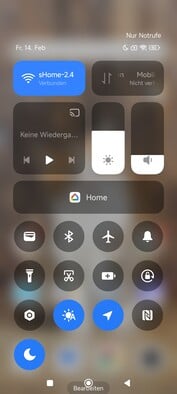
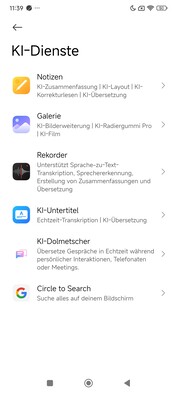
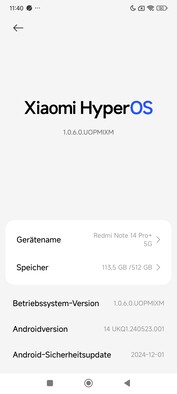
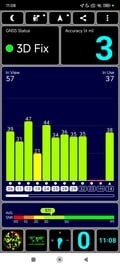
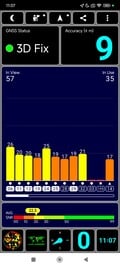










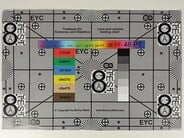









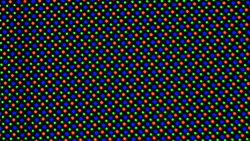
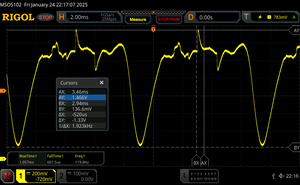





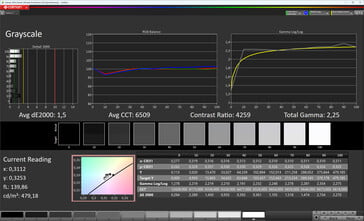


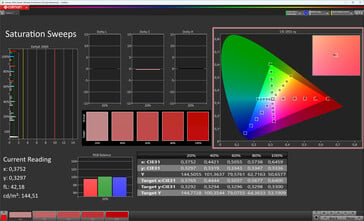
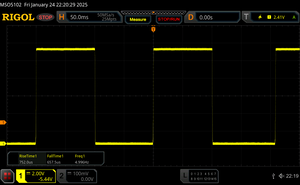
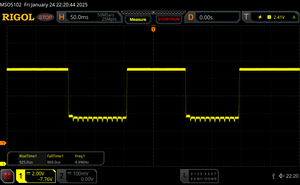






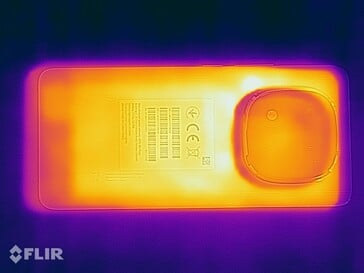
 Total Sustainability Score:
Total Sustainability Score: 








